HomePod (2nd-gen) review: The song remains the same
Expert’s Rating
Pros
- Great audio quality
- Beautiful design
- Detachable power cable
- Bass is less dominant
Cons
- Siri is unreliable and frustrating to use
- Can be picky about suboptimal Wi-Fi
- Bass is less dominant
Our Verdict
If you’re deep in the Apple ecosystem and your Wi-Fi signal and frustration threshold are both strong, this is the smart speaker for you: it will play your music beautifully and make TV watching a delight. Just be prepared to repeat yourself, and listen to a bunch of songs you never asked for.
Price When Reviewed
$299
Best Prices Today: Apple HomePod (2nd generation, 2023)
$103.34

$119.99

$299

$299.99
Well this was a surprise. Apple ditched the HomePod back in 2021, indicating breezily that it intended to focus instead on the smaller and cheaper HomePod mini. But now it’s come crawling back, professing undying affection for the full-sized form factor.
Or, in less dramatic terms, Apple has launched a 2nd-gen HomePod, and everyone is wondering what’s changed, and why the company thinks this time will be more successful. In our in-depth review of the 2023 HomePod, we intend to find out.
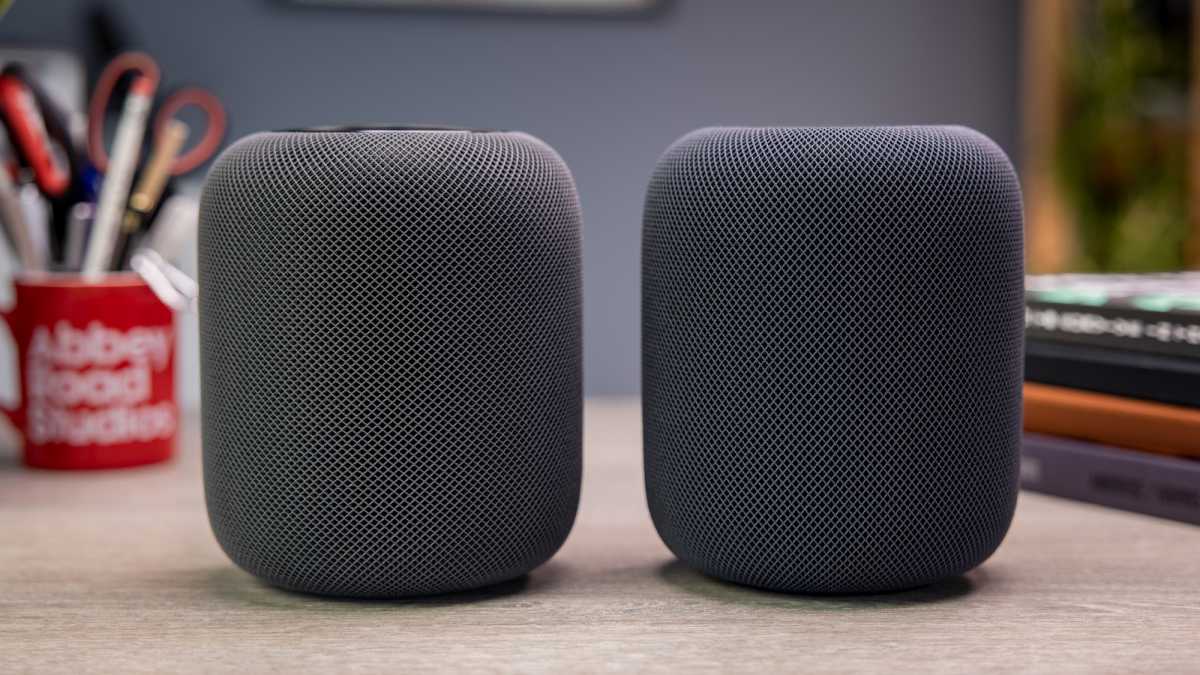
Dominik Tomaszewski / Foundry
Design and build quality: Much the same, in a good way
The HomePod 2 is a handsome speaker. It’s a neat, chunky but relatively compact cylinder with the edges smoothed off at the top and bottom. As with the very first iPad, the inward curve at its base invites the hand to pick it up. This feels like a very organic design, somehow, a shape that’s unobtrusive, human, and vaguely marshmallowy. It still feels modern, too, despite being barely any different from the 2018 original.
Indeed, at a first glance it’s difficult to spot the external differences between the first and second full-size HomePods. There are some—it’s a little shorter (by 4mm, which I didn’t notice) and lighter (by 200g, which I did)—but the overall look is nearly identical.
The diamond mesh pattern is fractionally finer now (by my reckoning each diamond on the main surface is now 2.5mm wide, compared to 3.5mm on the first-gen model, and I trust this vital data helps you make an informed buying decision) while the color of the black model, branded as Midnight, now has more noticeable hints of blue.
I’ll mention in passing that it strikes me as a great shame that the wonderful colors currently available on the HomePod mini, including a fine autumnal orange that I bought the moment I saw it, are not offered here. The mini had to wait around a year to get options beyond the classic black and white, and that may well be the case with this model too; but if so, it’s harsh on the early adopters. Perhaps it’s worth waiting until next Christmas to see if the orange finish appears.
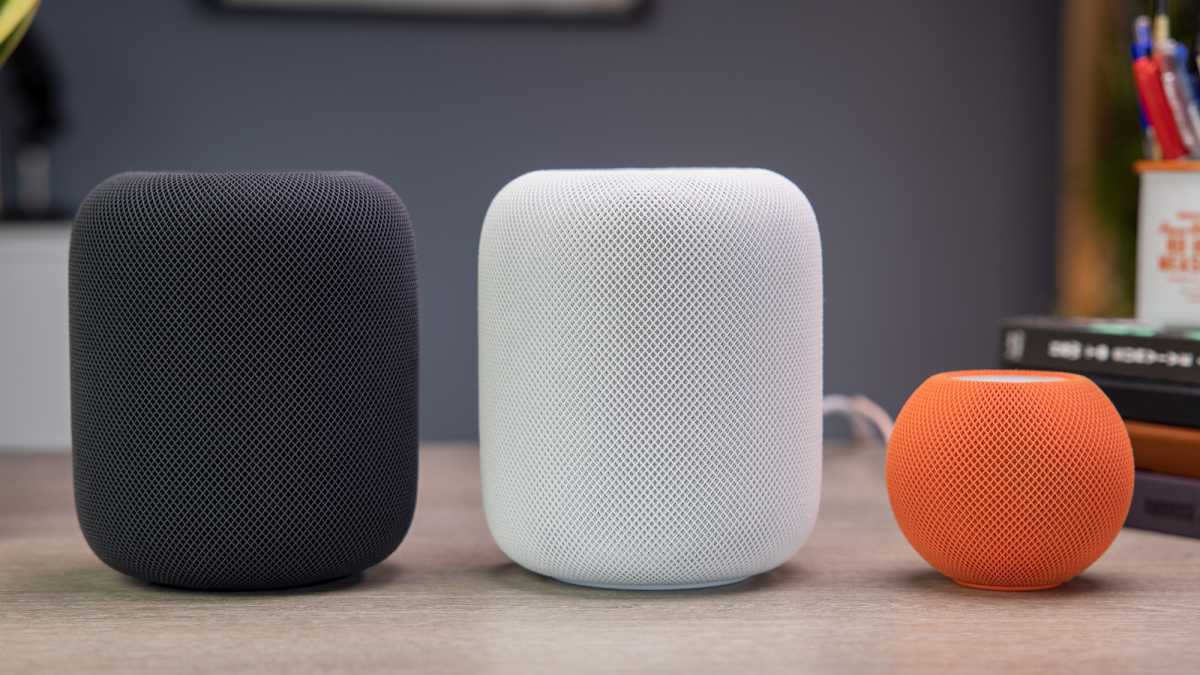
Dominik Tomaszewski / Foundry
More significantly, the screen on the top has seen some changes. The space is a little smaller (roughly 8.2cm across, compared to 8.9cm on the previous model) but the screen itself is larger to fill up more of it. When you’re talking to the device, the entire circle fills with the swirling colors of the Siri animation rather than just glowing in the center. It still feels like the screen is underused—I’d love to see track details and artwork, for example—but it’s at least easier to tell when Siri has been activated from across the room. The volume indicators, meanwhile, are now permanently marked on the screen rather than just appearing through a software interface, which is nice: I would often try to activate the screen of the original model to summon the volume keys and inadvertently pause the song that was playing instead.
The screen is also now slightly more inset. It was the very highest point of the original HomePod, but on the more volcano-like HomePod 2, it lies 3mm or so below the rim of the speaker mesh, which may offer some protection from dropped objects. Drop a set of keys on your HomePod (not recommended) and the screen will still take likely scratch, but with a larger and flatter object, the softer and obviously less scratch-prone speaker mesh will take the impact. On the other hand, this inset screen is harder to clean and more prone to collect dust in the recesses.
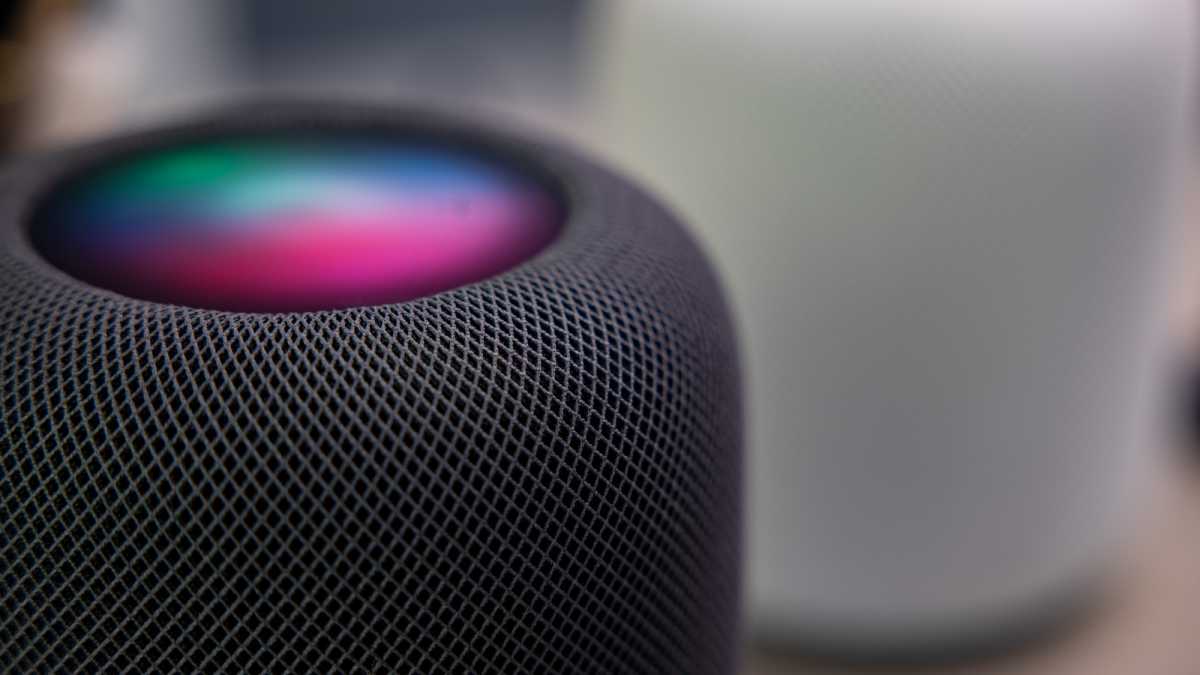
Dominik Tomaszewski / Foundry
There are two more external changes I can see, and these may both be intended to placate complaints from the original launch. The power cable is now removable, praise be, which may save some speakers from premature obsolescence and makes life easier for those who want to set up their HomePod in a piece of furniture with small cable gaps.
Finally, the base is now a flat and quite hard circle with only the Apple logo slightly indented in the center, whereas previously there was a decent-size circle cut out of the base, leaving the device’s weight pressing down on a ring of softer material. I have no inside information on this change but it may be related to the rings reported when putting white models of the original HomePod on dark or wood-finish furniture. (The HomePod mini also goes for a disc rather than ring base, by the way, so Apple’s designers presumably came up with this solution a few years back.)
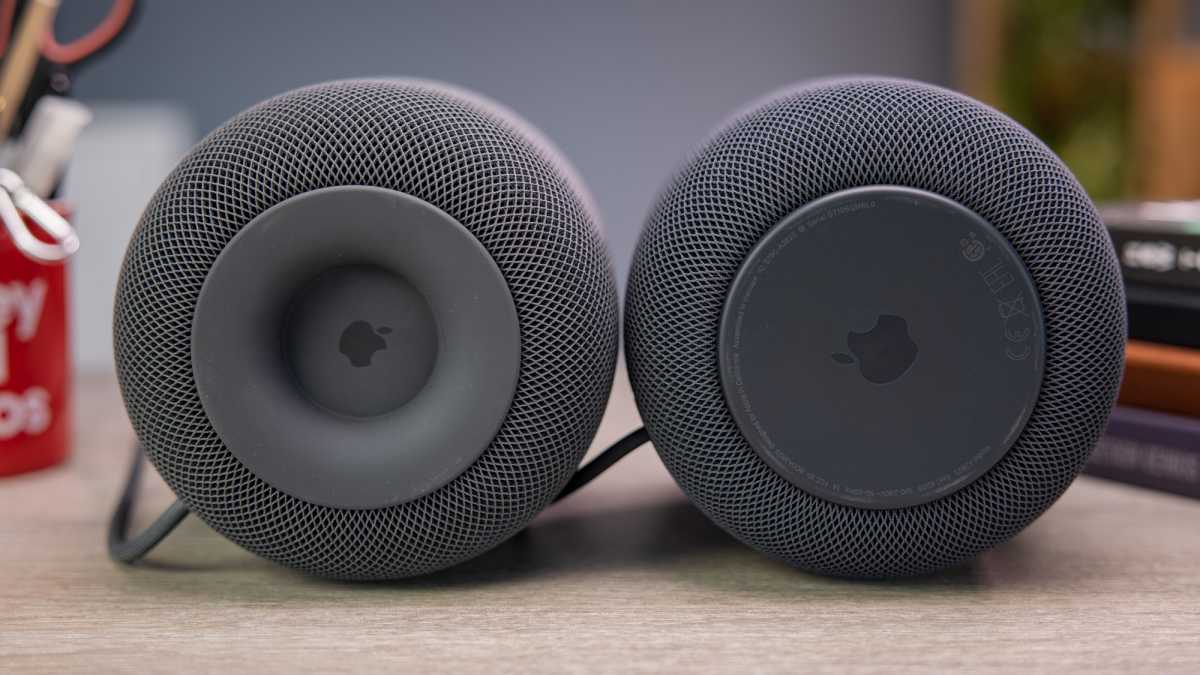
Dominik Tomaszewski / Foundry
I set up new HomePods in both white and black on scrap pieces of chipboard for the duration of my testing, fearing for the surface of my TV cabinet, but in the event neither left a mark that I could spot. Still, I’d recommend the precaution of using a coaster or plumping for the black model (which is less prone to becoming grimy over time anyway), since at least one other reviewer claims to have still noticed rings with the white one. He said the problem was far less severe but hadn’t been fixed completely.
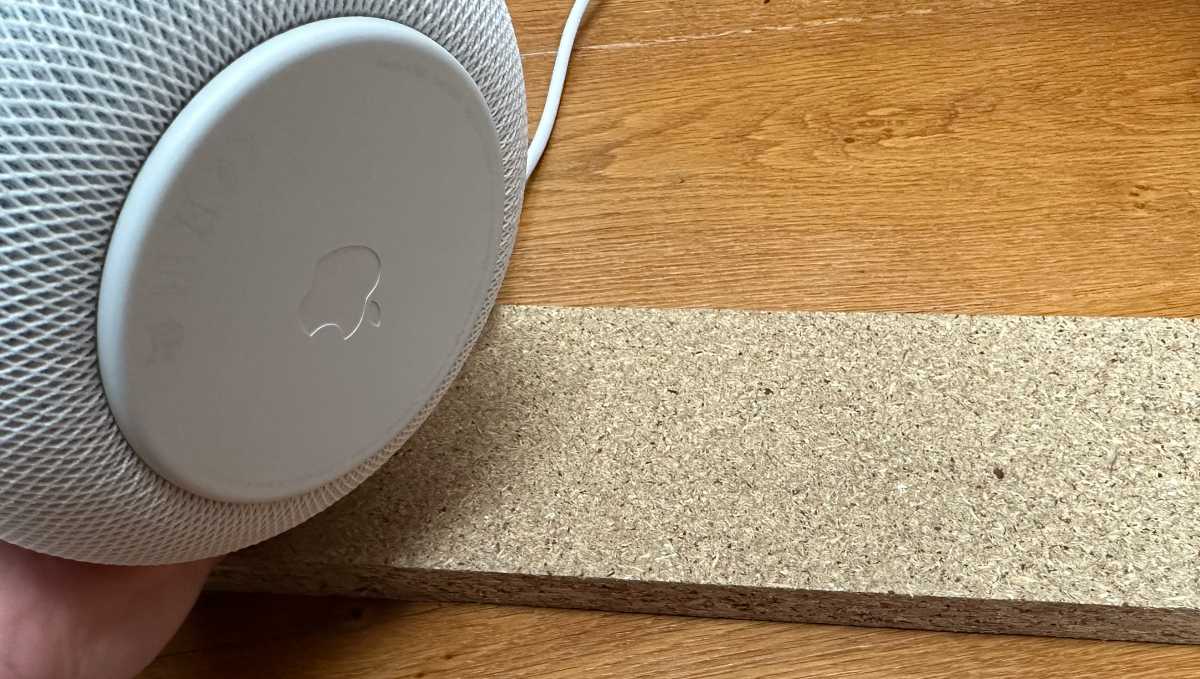
David Price / Foundry
Setup: Hard to fault, easy to use
As you’d expect from an Apple product, ease of setup is one of its strongest features. Plug in the HomePod and wave an iPhone vaguely in its direction and an onscreen popup (on the phone) will invite you to set it up. Tap to confirm, select a room and wait a few minutes, and it’s all sorted for you. If there’s another HomePod of the same model in the selected room, you’ll be given the option to join them as a stereo pair. This, too, is fast and straightforward.
In general, Apple users will find the HomePod an easy speaker to use. From the Music app, it’s simple to select one or more desired HomePods as an output (my only complaint is the app’s habit of lumping multiple HomePods together in the interface once they’re playing the same thing, which makes it slightly more awkward to separate them afterward) and I’ve found it similarly intuitive to stream to HomePods from the AirPlay interface of third-party audio apps such as BBC Sounds or TalkSport.
Controlling the HomePod via an iPhone, then, is broadly a positive and user-friendly experience. But Apple clearly intends for you to mainly control it with your voice using Siri–one clue is the iPhone’s occasional tendency to “lose” the connection and leave a track playing independently of its control–and that’s less pleasant, as we’ll discuss in a later section.
Audio experience: Great sound but lighter on bass
I’ll begin this key part of the review by stating for the record that I’ve had good listening experiences with all the HomePods I’ve tried: the original model and the HomePod mini produced rich and powerful sound for their respective sizes and prices, and based on past experiences, I felt confident about Apple delivering on the audio quality front even before I played the first song on the new HomePod.
Sure enough, songs sounded great through the 2nd-gen HomePod. Even without any major upgrades to the specs, Apple appears to have tinkered with the balance—again, likely in response to criticism that the original model was too bass-heavy—and on the majority of tracks that I tested it was preferable to the original model.
For classical, pop, most rock, and some jazz I preferred the HomePod 2’s delivery, which was richer, better balanced, more immersive, and more detailed at the top end. However, it’s worth pointing out that this rebalancing of the sound spectrum may not be to everyone’s taste, and on certain tracks, I continued to prefer the heavy bass sound of the original model: the first HomePod was better for dance and electronic music, and even some jazz songs with a major bass component. It would be nice to have some equalizer control and be able to adjust the balance to suit individual tastes, but as ever Apple feels that it knows best.
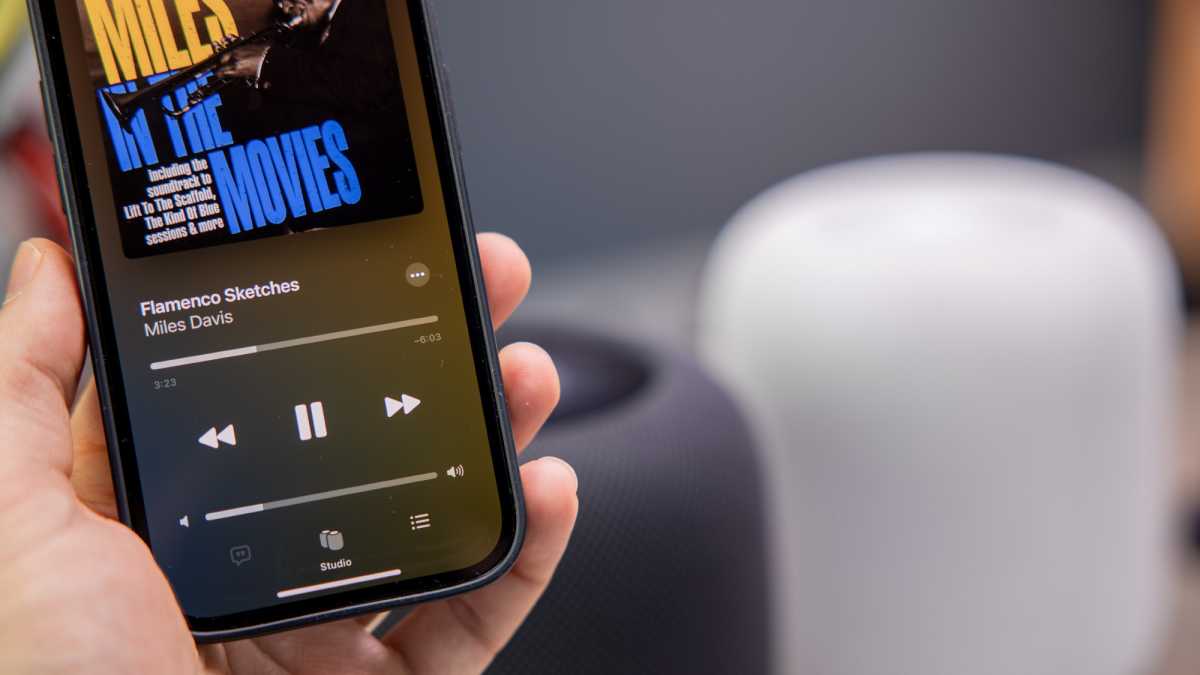
Dominik Tomaszewski / Foundry
You can read more detail about the blind tests I conducted to compare the two full-size HomePod models in a separate article, but I can summarise by saying that they definitely sound different, and I suspect that for the majority of tracks and to the majority of users’ tastes, the new model will be preferable. But fans of the original model’s punchy, muscular bass may be disappointed that this element has been dialed back.
These findings were a little surprising because Apple has actually reduced the number of tweeters covering the high end: there are now five of them, compared to seven in the previous model. My guess is that optimizations in the internal layout and other changes, such as the switch from an A8 processor to an S7 and the inclusion of an “all-new system sensor” for real-time audio adjustments to suit a room’s layout, have led to a rebalanced and in some respects improved sound.
For an audio experience that’s better still (assuming you’ve got a large budget) consider buying two HomePods and setting them up as a stereo pair. The effect of this in my tests was stunning, producing a rich, detailed, and overwhelmingly immersive sound. This works particularly well if you use them as TV speakers via an Apple TV, a move which transformed my enjoyment of the TV+ service, particularly when watching grandiose prestige programming such as Foundation.
Note that the new HomePod cannot be set up as a stereo pair with the first-gen model—the audio characteristics are evidently too different to work correctly in stereo—and certainly not with a HomePod mini. You can have two HomePods from different generations set up in the same room and have them both outputting the same track, but they will each play the full audio rather than knowing to separate into left and right channels. It isn’t as good, in short. And for those who’ve got a first-gen HomePod, the lack of cross-generational stereo support makes the additional purchase less appealing. (You could always have the two devices in separate rooms since AirPlay supports multiroom audio… or trade in the old model if someone makes you a good offer.)
Smart features: Siri lets the side down
As I’ve ranted elsewhere, Siri is the HomePod’s weak suit. It really lets down the whole experience.
Okay, let’s start with a positive note: the HomePod, despite having lost a couple of microphones (four vs six) is nevertheless excellent at noticing its trigger phrase. If someone says “Hey Siri,” no matter which member of my family speaks it and wherever they are in the room, and whichever direction they’re facing, and even if loud music is playing over the top, the HomePod lights up and prepares to tackle a command. Unfortunately, that’s where the problems start.
In my anecdotal experience, but backed by the testimony of many other users, it seems to mishear more often than Alexa, for example, and is more prone to guessing what’s wanted when it isn’t sure. This can result in extremely frustrating situations where it plays entirely the wrong song. On being told “Hey Siri, play Miles Davis,” for example, my HomePod chose instead to play “Monster (feat. Jay-Z, Rick Ross, Nicki Minaj & Bon Iver),” defying me to trace the bananas logic that led it to that track.
This would be frustrating enough, but fairly often the HomePod then carries on playing the wrong song against my wishes because it also can’t understand the command “Hey Siri, stop playing.” (One can only dream of the day when Apple enables its smart speakers to understand simple but vital commands like “Stop playing” on the device rather than having to access an internet connection, but today is not that day.) It is reasonably accurate, but the errors can be very annoying.
In terms of smart features, too, Siri on the HomePod is behind the bleeding edge of technological innovation. It’s not great at answering trivia questions, for example. For example, I asked, “How long is a whale?” and was told, counterintuitively, the runtime of the similarly named recent movie, and when I specified blue whale, it quoted the National Geographic (wildly mispronouncing both words, something I’ve noticed it does with the titles of songs on a regular basis) then gave a reasonably informative but rather meandering answer. Other HomePod users have reported similarly janky performance in this area.

Dominik Tomaszewski / Foundry
It was able to tell me the temperature easily enough, but when I asked the HomePod if I had anything in my calendar for the day, and to read out my most recent iMessage, it pled an inability to connect to the internet. The connection in my home is a little spotty, but the HomePod had just been streaming from Apple Music quite happily. In my experience Apple’s speakers can be annoyingly and selectively fastidious about Wi-Fi signal strength; this may be related to the S7 chip reportedly supporting the Wi-Fi 4 standard only, although I’ve had exactly the same issues with the previous model, whose A8 chip supported Wi-Fi 5. Perhaps matters would be improved by the addition of a newer iPhone chip and Wi-Fi 6, which Sonos is set to support in its next speakers but appears unlikely to appear in a HomePod any time soon.
On the plus side, the HomePod can also tell you the humidity, since this model has a sensor for that job. The HomePod mini also has a humidity sensor that was recently activated quite recently. The original HomePod hasn’t got that sensor, but it will scrape the relevant information from newer HomePods or other accessories on the same network if available.
Talking of component upgrades, the HomePod has also gained a U1 ultra wideband chip, something which was already included in the HomePod mini. This is designed to help you switch music smoothly from iPhone to HomePod and vice versa by simply bringing them close together (sadly it wasn’t terribly smooth in my testing, and tended to get confused and refuse to connect; perhaps network issues again) and introduces a feature where an icon for a nearby HomePod appears in the iPhone 14 Pro’s Dynamic Island and lets users see the song that’s playing and adjust the volume.
It’s not a new or unique feature, but I did as ever enjoy Intercom, which is brilliantly useful for families lucky enough to live in large houses. Ask one HomePod to “tell the living room that dinner is ready,” and it will broadcast that exact command–in your voice–in that room. You can then say “tell the kitchen I’m on my way” and acknowledge the message in efficient fashion. Sure, Amazon smart speakers can do this perfectly well too, but it’s a useful and nicely executed feature and it’s worth celebrating the wins when they come.
One smart feature I’m intrigued by, and may well end up saving the property or even lives of HomePod owners some way down the line, is called Sound Recognition which enables the device to listen out for and detect sounds such as smoke and carbon monoxide alarms, and then inform the owner remotely via an iPhone alert. This isn’t enabled yet, but will reportedly be added in a software update this spring.
Incompatibility: Not brilliant at playing nicely with others
Some perennial complaints now. Apple is plainly still keen on making the HomePod part of its walled garden ecosystem and makes life harder for those who don’t pay for its other products and services. Things run much more smoothly, for instance, if you subscribe to Apple Music, the service for which the HomePod was designed. Apple is beginning to open up to the idea of working with other streaming services, and you can now set some, including Deezer and Tidal, as the default when Siri hears a command to play a song. But there are big gaps in the list since Spotify, YouTube Music, and Amazon Music aren’t options. There’s also no support for straight Bluetooth playback, though you can AirPlay from these apps to the HomePod, but it removes the voice assistant aspect that the designers clearly intended to be the primary control method. And as always, Android devices can’t be used to set up or pair with a HomePod.
There is one bright spot on the inter-compatibility front, however: The 2023 HomePod gains support for the Matter standard, which means that in the future it will be able to control a far wider range of smart-home accessories. In the past HomePod owners have been limited to Apple’s vetted ecosystem of HomeKit products, but the range hasn’t really taken off as hoped. Having access to this new cross-party standard, supported by Amazon, Google, and Samsung, among others, is a promising move.
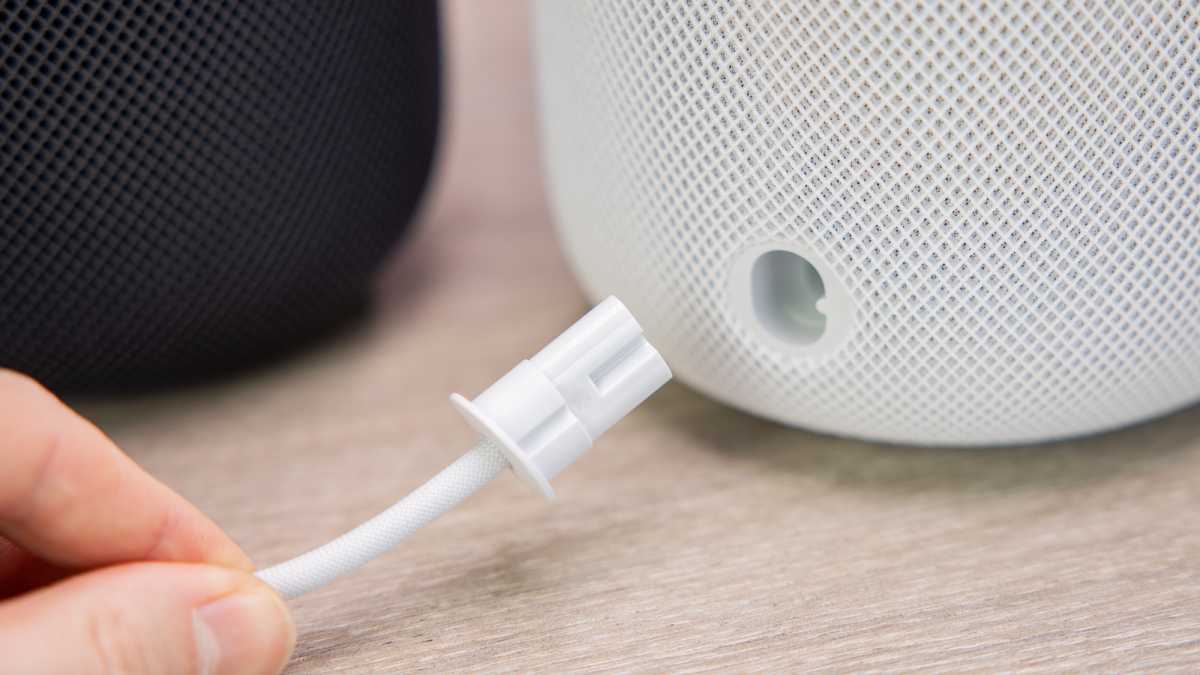
Dominik Tomaszewski / Foundry
Verdict: Improvements, but not the ones we wanted
I like the new HomePod: I just can’t help it. It looks lovely, delivers a pleasing sound (and a superb sound when set up as a stereo pair), and is a breeze to set up and use with my network of Apple products. The problem is that all of those things were true back in 2018, and the most serious flaws of the original model haven’t been addressed at all.
Sure enough, the dominant bass has been rebalanced (as if that was a bad thing!), white rings are less of a worry, the power cable is detachable, the screen is used better, and there are some handy new features such as temperature and humidity sensing, and the upcoming Sound Recognition. With the exception of the bass, which is subjective, these are all clear improvements. But for me at least, the greatest flaws of the original HomePod were Siri’s glaring incompetence, and the device’s frequent (but inconsistent) inability to connect to a Wi-Fi signal that most other devices can handle without too much difficulty. Based on my testing, neither of these has been fixed, and if anything Siri seems worse than ever.
So it’s a qualified recommendation. If you’re deep in the Apple ecosystem and your Wi-Fi signal and frustration threshold are both strong, this is the smart speaker for you: It will play your music beautifully and make TV watching a delight if you spring for a second. Just be prepared to repeat yourself, and listen to a bunch of songs you never asked for.
For all the latest Technology News Click Here
For the latest news and updates, follow us on Google News.
